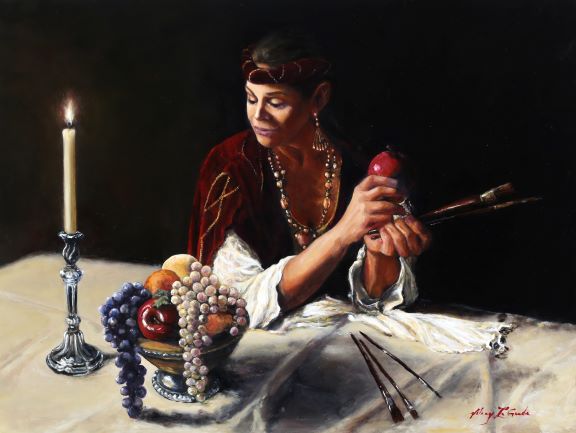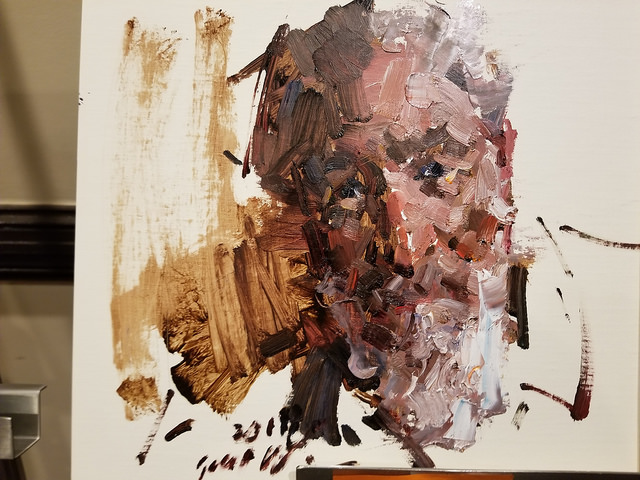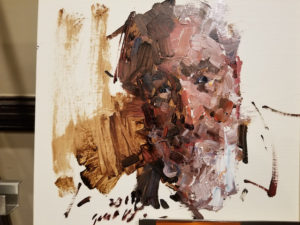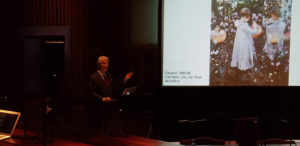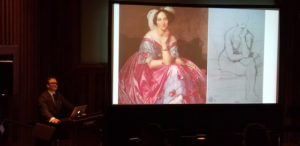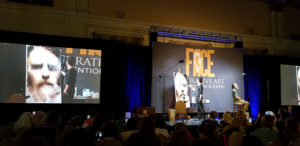FACE provides a tremendous opportunity for figurative artists to connect with fellow artists, learn new art techniques, and receive tips on how to market their art. There are typically at least three lectures or demonstrations going on at the same time from 8:30 am to 9:30 pm. Choosing which lecture or workshop to attend is a dilemma.
I started today by attending a demonstration by Jove Wang. Wang is an oil painter who was trained in the China Academy of Art which is extremely prestigious and difficult to get into. He also received training at the Tokyo Academy of Art. He’s been commissioned by the Catholic Church in Los Angeles. He often paints the indigenous cultures of China. Today he painted a quick portrait of one of my instructors, Virgil Elliott.
His application of paint was fast using a loaded brush at times. He focused on how light and shadows react over form. He uses a simple palette of color and often mixes directly on the canvas with a broad filbert brush. He said artists should make sure to have the soul to be passionate.
Next, I attended a talk by Neill Slaughter, PhD. He spoke about the “Triumphant Triad” of Sargent, Sorolla, and Zorn.
All three of those artists were realists in the 19th Century. They often collaborated with one another and competed with one another. Each would explore different expressionistic abstracts and develop an almost identical palette as their work matured. Dr. Slaughter explained with great detail the characteristics of this triad of painters and the representational art they left behind for future generations.
Next, I attended a lecture by Micah Christensen, PhD. Dr. Christensen presented a lecture about photography and art. He recommends www.ForgottenMasters.com for reference.
The French artist Jean-Auguste-Dominique Ingres was a good example of a classical artist who painted before photography came into existence. He broke free from the direct natural observation of a subject which had led other artists to simply paint an exact duplicate of the subject. Instead, Ingres idealized his subjects which made his paintings more intriguing.
In 1839, a Frenchman named Louis-Jacques-Mandé Daguerre developed what became known as the “Daguerrotype” camera. One of the first artists to use the camera to assist in his painting was Paul Delaroche who is one of the painters featured in an exhibit currently appearing at the Houston Museum of Fine Arts. The exhibit is called Tudors to Windsors: British Royal Portraits from Holbein to Warhol. It will end on January 27, 2019.
In 1910, Joaquín Sorolla y Bastida used photography to assist him in his painting. This became seen as a tool to improve the quality of paintings by classical realist artists.
I caught a painting demonstration by Casey Baugh entitled “Unknown Techniques”.
He used a large canvas, paint brushes from Home Depot, fine oil paints mixed with a medium called Prohibition. I spoke to the vendor who markets Prohibition. She tells me that it is a combination of medical grade turpentine, linseed oil, and Damar varnish. Baugh literally splashed paint onto the canvas using his Home Depot brushes.
Here is the resulting painting.
I also attended a series of lectures to help artists learn how to market their art. Some of the speakers included Amanda Theis, Elizabeth Hollings, Carolyn Edlund, and Eric Rhoades.
It was a long but interesting day. More tomorrow.
